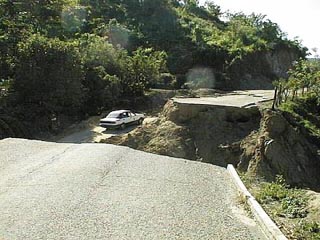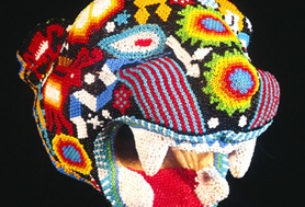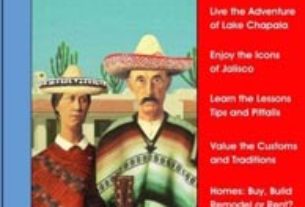
We are tall, white, middle aged and well fed. They are short, dark and thin. We are foreigners and they are native born, “Indio”, indigenous. We are retired academicians and professionals and they are farmers, ” campesinos“, “peasants”. We are donors to a relief effort that was mounted in response to the devastating earthquake and monsoon rains that occurred in October of this year. They (some 120 of them) are among the survivors.
We have come to this large warehouse on the outskirts of Oaxaca city by invitation of one of the four organizations responsible for collecting relief, to attend a press conference and to witness the process by which goods are being actually distributed. We have no idea what to expect, except that we had asked our host to please not make any special recognition of our efforts. What we learn in the process will affect our thinking and our perceptions about Mexico, Oaxaca, and ourselves.
San Lorenzo Texmelucan is the central village for seven communities with 800 families. Located on the western slope of the southern mountains of Oaxaca, above the road between Puerto Escondido and Acapulco, it is not a tourist destination. Neither are the other communities represented here, containing almost 4,000 families.
“Emiliano” is a district delegate. He lives in the central village of a “municipio” (township) containing seven communities and 800 families.
When he is not farming, Emiliano teaches his neighbors about their rights under Mexican law, helping them to organize themselves in order to claim some simple freedoms that we take for granted, and for which they and their ancestors have shed blood to achieve, so far with limited success.
After the paper is read, the reporters ask questions. One asks about the actual conditions in Emiliano’s village. Like most of the “Indios” present, Emiliano prefers not to make too much eye contact, as it is considered aggressive. His Spanish is slow, and clear, and I wonder if perhaps it is a second language for him. He tells us that 70 to 90 percent of all buildings in his area are uninhabitable; that there is not enough purified water, so that people are forced to drink from uninspected water sources; that all the crops have been destroyed; that the road from the district center to his community, which is unpaved, is impassable because a landslide sent ninety feet of it down the mountain.
The government, he tells us, has not put in an appearance, although the Army touched down briefly while doing an “assessment” of needs a month or so ago. “We told them we need everything; we have nothing left. They promised to return soon. We never saw them again”.
“Armando”, from another village, works to help campesinos organize around land reform issues. In his village, he tells us, there are only two houses left standing. When they lost their homes, the villagers set up tin and plastic shelters on the village basketball court, the only flat and firm surface around. After a while, the “municipal authority” imposed on them by the central government came around and told them they must leave, because the encampment looked bad, and was an embarrassment. What if someone from the outside saw this? They might think that the authorities couldn’t take care of their citizens…
One of the staff members has taken us in tow, and seated us in the back row of folding metal chairs that were brought into the warehouse for this meeting. Only about two thirds of the attendees can sit on chairs, as the crowd is unexpectedly large. We offer to stand, or sit on stacks of beans as others are doing, but are told that if we abandon our seats no-one will take them. We are guests.
Over and over, men and women, young and old, get up to report to the press about the terrible conditions they are enduring in their villages, and about the indifference of the authorities to their situation. In doing so, they are also reporting to each other.
This sharing of experiences – and of possible solutions – is the result of years of painstaking and often dangerous work that is being done by “non governmental” (read: non-profit, non-political, non-official) organizations, here and elsewhere in Mexico.
The four organizations who are overseeing this campaign in Oaxaca all have been working in the affected area for some time. If they had not, they never could have pulled this effort together. They have been organizing the local folks for awareness of, and agitation for, human rights, educational opportunities, intertribal co-operation, and sustainable agriculture. It is tricky work. The “coyotes” (middlemen) who buy their coffee at bargain basement prices do not like it when the farmers decide to form a cooperative and sell it themselves. Neither do their friends in authority with whom they share their profits. The landlords for whom most of the campesinos work as sharecroppers do not think that peasants should be taught to read, as they may “misinterpret” the one-sided contracts they must sign in order to work. The vendors of poison chemicals are not overjoyed when local farmers begin discussing organic farming methods.
” Poco a poco” (little by little), the concept of mutual aid has been reawakened among a people suffering the effects of over 500 years of colonization, and little by little, in a quiet and respectful way, it has been suggested that perhaps the individual villages ought to set aside old grudges and find ways to communicate with each other; that they might find that they have much more in common than they do in disagreement; that they might, in such a case, draw strength from each other. And it is this work, built up over years of patient and respectful listening and learning on the part of the teachers, that has culminated in this extraordinary process which we have the privilege of witnessing.
Everything that comes in and goes out from this warehouse is accounted for. All the statistics are published and distributed to everyone. The villagers themselves load the trucks in Oaxaca and unload them at their destination. Nothing gets diverted, and nobody profits.
The schedule and methods of distribution for the beans, corn, salt and sugar that leave this warehouse were debated on the community level. The representatives here were elected by the people to carry out their wishes. Some forty-five communities of nearly 4,000 people are communicating, co-operating, and building bridges that will take them into the future together.
Oaxaca has always had bad times. Everyone, no matter how old, can remember more than one disaster that befell them in their lifetimes. Everyone lives with the knowledge that the latest one was not the last one. Fatalism is part of the birthright of the marginalized. These organizations, and this campaign, have added hope to these lives: hope that next time, the pathways of communication and co-operation they have built together will help them to survive a little better; each time a little better.


